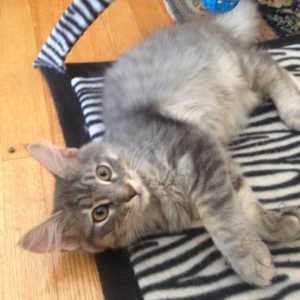Hairball Awareness Day: How to Reduce Your Cat’s Hairballs
 Cats are meticulous cleaners. They spend a lot of time taking care of their hair and nails, which is a good thing. However, when cats groom, their sandpaper tongues pick up hair, which they then swallow. Most of this hair passes normally. However, sometimes hairballs arise.
Cats are meticulous cleaners. They spend a lot of time taking care of their hair and nails, which is a good thing. However, when cats groom, their sandpaper tongues pick up hair, which they then swallow. Most of this hair passes normally. However, sometimes hairballs arise.
April 28th is Hairball Awareness Day. Seriously, we didn’t make this up. So let’s take the time to ‘celebrate’ by sharing a few ways pet parents can reduce the amount of hairballs they and their babes have to deal with.
Reduce Stress to Reduce Licking
It’s normal for a cat to spend 30%-40% of their waking hours on grooming. However, some cats get out of hand with their cleaning. Excessive grooming, called psychogenic alopecia, can occur for a number of reasons. Stress is a big one. Reducing that stress can help reduce the licking.
Routines and consistent environments are important to cats. When these change, so do attitudes. New people or pets in the home, moving to a new home, changed meal times, and even a change in their human’s hours can affect a cat’s stress level. When making changes, do so as gradually as possible. Try not to change more than one routine at a time.
Another way to keep stress levels low is to keep food in a safe, quiet place. Cats don’t like feeling vulnerable when eating. They need to be able to have peaceful meals without constantly worrying about noise or movement interfering.
Cats also like to do their business in peace. This is another source of vulnerability. Put their litter box in a quiet place that sees little traffic.
If you notice your cat is licking so much that bald patches or broken skin appear, contact your veterinarian for an evaluation.
Help with Grooming
Regularly brushing your cat carries a lot of benefits. It helps distribute natural oils, prevents tangles and mats, and encourages good circulation. It also allows you to stay familiar with your pet’s body and helps you bond with your babe. And of course, brushing removes loose hair that would otherwise end up inside your kitty’s belly. This is a huge help in hairball reduction. Ideally, cats with long, luscious locks need a daily brush at least. For cats with short hair, you can get away with a quick and gentle once over a few times per week.
In addition to regular brushing, professional grooming is also important to keep excess hair at bay. This is because the pros go far beyond a simple brush. Aside from other imperative services (nail trimming, ear cleaning, and anal gland care), professional grooming can include brushing, trimming, shampooing, and de-shedding, depending on the specific needs of your cat. This kind of thorough care not only leaves your cat feeling fresh and fine, but it also reduces the amount of hair they ingest.
 Talk to Your Veterinarian
Talk to Your Veterinarian
If your cat has a big problem with hairballs, it may help to have a conversation with your vet. He or she may recommend a special food designed to help with hairballs. They may also have advice about lifestyle changes that can improve the health of your cat’s skin, hair, and mental state, which can in turn help with hairballs.
Dealing with hairballs is one of the least fun parts of being a pet parent. They’re also uncomfortable for our kitties. It’s important for everyone’s sake to do all that’s possible to decrease the amount of hair that ends up in our babes’ bellies. Lowering your cat’s stress, keeping good grooming habits, and communicating with your vet all help with this.
At Awesome Doggies, our professional groomers are experts at helping cats feel and look great. Contact us today for an appointment, and we’ll come to you.
